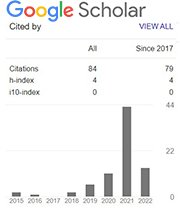Development of Coastal Tourism Potential Lombang Beach Based on Customer Perceived Value
Abstract
The potential that exists in the northern coastal area of Sumenep Regency is very diverse and abundant. In line with the sector that is being intensively developed by the Indonesian government, namely the tourism sector. Indonesia is also classified as a maritime country which certainly makes it one of the various factors why Indonesia is aggressively developing the coastal or marine tourism sector. This is inseparable from the principle of sustainable tourism development which maintains the integrity of natural, economic and social development, and ensures the maintenance of natural and cultural resources. Considering that Madura is a popular tourist island with 126 small islands and 48 inhabited islands, Sumenep Regency has the greatest potential for the development of coastal or marine tourism in Madura. The purpose of this study was to determine the development of coastal tourism in Lombang Beach based on customer perceived value in Sumenep. This research is a community mapping using qualitative methods with semi-structured interviews to obtain in-depth results in describing research results based on aspect categories. The research respondents were 24 Lombang beach tourists in Sumenep. The results of this study present a from of development that has been concluded based on costumer perceived value, where the results of respondents' submission based on aspects are described with different levels, as for things that need to be maintained, improved and developed from Lombang Beach both in terms of services, environment, and physical facilities in order to provide a positive experience to Lombang Beach tourists.
Keywords: Coastal Tourism, Customer Perceived Value, Lombang Beach, Sumenep, Community MappingKeywords
Full Text:
PDFReferences
References
Ardiansyah, K., & Nugroho, A. A. (2022). Pengaruh Daya Tarik Wisata , Aksesibilitas dan Fasilitas Terhadap Keputusan Berkunjung Wisatawan ke Pantai Siangau Kabupaten Bangka Barat. Jurnal Ilmu Ekonomi Manajemen Dan Akuntansi, 11(1), 101–113. https://doi.org/https://doi.org/10.33319/jeko.v11i1.102
Azhar, I. N. & Surokim (2019). Madura 2040: Masalah dan Strategi Pengembangan Pariwisata Madura. Malang: Inteligensia Media.
Baiquni, M. (2002). Integrasi Ekonomi dan Ekologi dari Mimpi Menjadi Aksi,” dalam Wacana, III, 12, 202.
BPS Kabupaten Sumenep. (2022). Kabupaten Sumenep Dalam Angka 2022.
Bungin, M. B. (2009). Penelitian Kualitatif. Cetakan ke 3. Jakarta: Kencana Prenada Media Group.
Corte, V. D., Sciarelli, M., Cascella, C., & Del Gaudio, G. (2015).
Customer satisfaction in visitor destination: The case of tourism offers in the city of Naples. Journal of Investment and Management, 4(1–1), 39–50. https://doi.org/10. 11648/j.jim.s.2015040101.16
Hendriyani, I.G. (2022). Siaran Pers: Menparekraf Maksimalkan Pengembangan Wisata Alam, Sejarah dan Ekonomi Kreatif di Sumenep [Halaman web]. Retrieved from https://kemenparekraf.go.id/berita/siaran-pers-menparekraf-maksimalkanpengembangan-wisata-alam-sejarah-dan-ekonomi-kreatif-di-sumenep
Kushanto, I. C. (2020). Correlation Between Perception of Customer Experience and Revisit Intention on Jogja Bay Waterpark’s Visitor. Sanata Dharma University.
Moertijoso, R. B. (2011). Perumusan Core Value City Branding Kabupaten Sumenep Sebagai Representasi Kearifan Lokal dan Potensi Daerah, 18–25.
Moleong, L. J. (2014). Metode Penelitian Kualitatif Edisi Revisi. Bandung: Remaja Rosda Karya.
Moleong, L. J. (2017). Metodologi Penelitian Kualitatif. Bandung: PT Remaja
Nafisah, C. (2018). Pengelompokan Kabupaten/Kota Di Jawa Timur Berdasarkan Jenis Daya Tarik Wisata Menggunakan Analisis Cluster. Institut Teknologi Sepuluh November.
Nasution dan Ardin, 2010. Consumer Perceived Value Analysis of New & Incumbent Brands of Gudang Garam & Sampoerna. The Asian Journal of Technology Management Vol. 3 No. 1 (2010) 16-30
Neuman, (2013). Metodologi Penelitian Sosial: Pendekatan Kualitatif dan Kuantitatif. Jakarta: PT. Indeks.
Prebensen, N. K., Woo, E., Chen, J., & Uysal, M. (2012). Motivation and involvement as antecedents of the perceived value of the destination experience. Journal of Travel Research, 52(2), 253–264. https://doi.org/10.1177/ 0047287512461181
Sugiyono, D. (2017). Metode Penelitian Kuantitatif, Kualitatif, dan R&D. Bandung : Alfabeta.
Wu, H.-C., & Li, T. (2017). A study of experiential quality, perceived value, heritage image, experiential satisfaction, and behavioral intentions for heritage tourists. Journal of Hospitality & Tourism Research, 41(8), 904–944. https:// doi.org/10.1177/1096348014525638
Zeithaml, V. A., Bitner, M. J., & Gremler, D. D. (2017). Services marketing: Integrating Customer Focus Across the Firm. In Business Horizons (Seventh Ed, Vol. 51, Issue 3). McGraw-Hill Education. https://doi.org/10.1016/j.bushor.2008.01.008
DOI: https://doi.org/10.21107/personifikasi.v15i1.26013
Refbacks
- There are currently no refbacks.
Copyright (c) 2024 Mery Atika

This work is licensed under a Creative Commons Attribution 4.0 International License.


Personifikasi by Universitas Trunojoyo Madura is licensed under a Creative Commons Attribution 4.0 International License.










